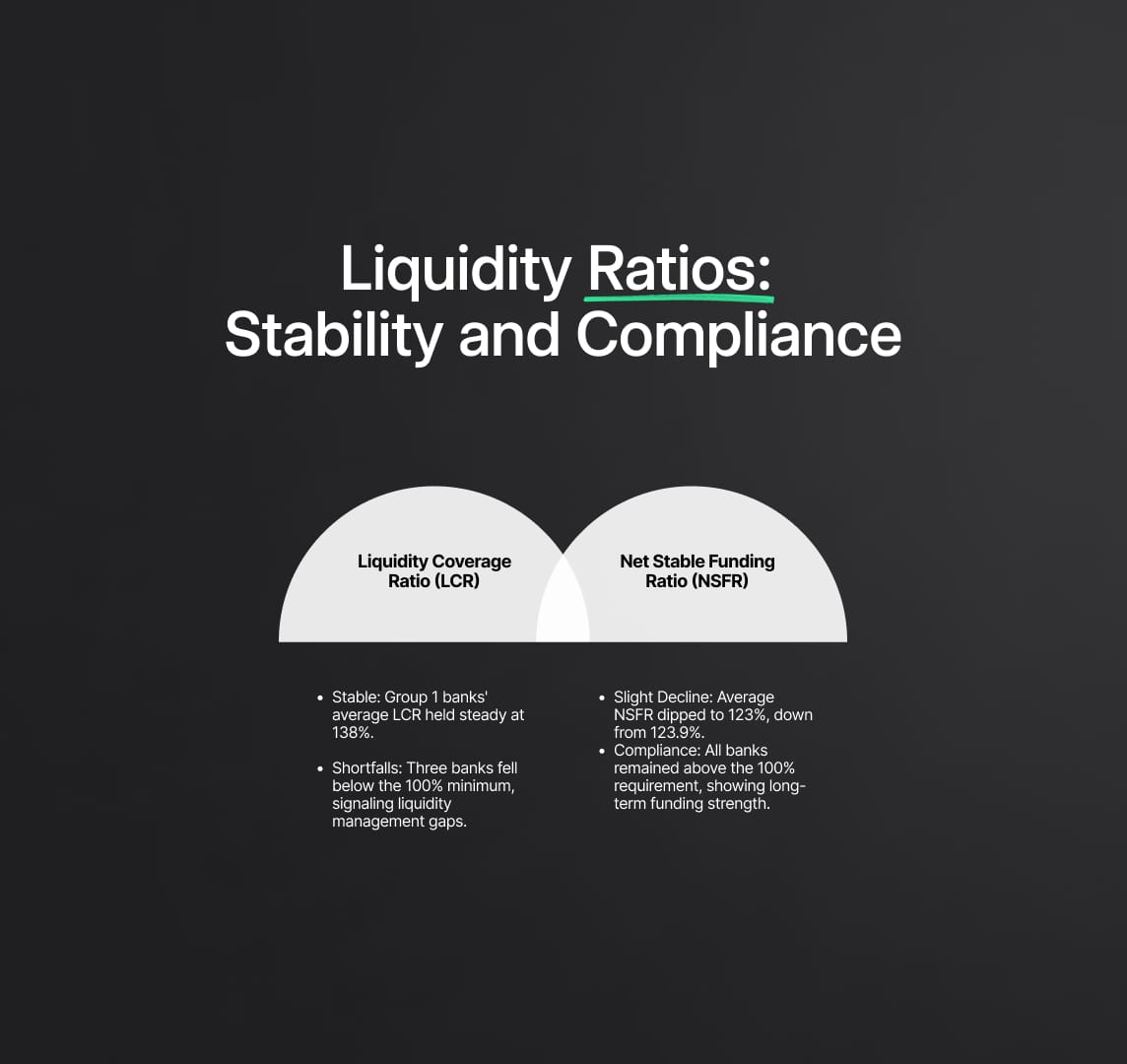Basel 3 framework: capital and liquidity ratios monitoring
Basel 3 framework strengthens global banking resilience, with the latest monitoring showing stable capital and liquidity ratios in 2023 and highlighting compliance with key Basel III standards.

The Basel III framework continues to play a pivotal role in strengthening the global banking system's resilience. According to the latest Basel III monitoring exercise published on 7 October 2024, both capital and liquidity ratios remained stable in the second half of 2023. This comprehensive analysis provides valuable insights into the banking sector's health, especially concerning the implementation of Basel III standards.
Basel III Monitoring Exercise
The Basel Committee on Banking Supervision conducted its regular monitoring exercise using data as of 31 December 2023. The report examines trends in current bank capital and liquidity ratios and assesses the impact of the fully phased-in Basel III framework. The study encompasses 180 banks, including 118 large internationally active banks classified as Group 1 and 62 smaller banks designated as Group 2.
Basel III regulatory reforms cover an array of risk-related factors that continue to influence capital adequacy, liquidity profiles, and leverage standards. The Basel III monitoring exercise provides granular analysis on these impacts, leveraging risk-based models and capital metrics to evaluate progress across different bank groups and regions.

Basel 3 Capital Ratios: Slight Increases and Decreases
Current Capital Ratios
- Increase in Current Capital Ratios: The average Common Equity Tier 1 (CET1) ratio for Group 1 banks increased slightly to 13.1% from 12.9% at the end of June 2023. This slight rise in capital buffers reflects ongoing compliance with regulatory requirements and internal adjustments, driven by an emphasis on resilient capital structures and better risk management practices. For G-SIBs (Global Systemically Important Banks), meeting their capital adequacy targets under Basel III is crucial due to their systemic importance in the global financial system.
- Stable Dividend Payout Ratios: Large internationally active banks maintained stable dividend payout ratios during this period. The interplay between dividends and capital accumulation strategies is essential for banks to balance stakeholder expectations while maintaining strong capital positions under Basel III's scrutiny.
- No Capital Shortfalls: Group 1 banks reported no total regulatory capital shortfalls, an improvement from a shortfall of €3.3 billion at the end of June 2023. This highlights a significant enhancement in capital planning and management. Basel III's stringent requirements on capital conservation buffers and countercyclical capital buffers have continued to influence the banking sector’s ability to shore up capital in response to changing macroeconomic conditions.
Fully Phased-In Basel III Capital Ratios
- Decrease in Fully Phased-In Ratios: The CET1 ratio under the fully phased-in Basel III framework decreased slightly to 13.5% for Group 1 banks. This reflects the finalization of Basel III capital reforms, where banks face higher capital requirements, and the output floor enforces minimum capital levels. The CET1 requirement ensures that banks hold sufficient high-quality capital to absorb losses.
- Impact on Tier 1 Minimum Required Capital (MRC): The average impact on Tier 1 MRC for Group 1 banks was +1.3%, down from +2.4% at the end of June 2023. The MRC measure serves as a critical benchmark for evaluating the sufficiency of Tier 1 capital under both current and projected standards.
- Reduction in Tier 2 Capital Shortfalls: There were no Tier 2 capital shortfalls reported, compared to a €3.3 billion shortfall previously. This reduction reflects ongoing efforts to optimize capital structures in line with Basel III's phased implementation. Tier 2 capital remains essential for absorbing losses, albeit at a lower priority compared to Tier 1.

Liquidity Ratios: Stability and Compliance
Liquidity Coverage Ratio (LCR)
- Stable LCR: The weighted average LCR for Group 1 banks remained stable at 138%, compared to 138.5% in the previous reporting period. The LCR mandates that banks hold a sufficient stock of high-quality liquid assets (HQLA) to cover net cash outflows during a 30-day stress period. This ensures short-term liquidity under adverse market conditions, further safeguarding the banking sector against liquidity crunches.
- Compliance with Minimum Requirements: Three Group 1 banks reported an LCR below the minimum requirement of 100%, indicating a need for improvement in liquidity management. This shortfall underscores the challenge some institutions face in aligning with the stringent liquidity demands imposed by the Basel III framework.
Net Stable Funding Ratio (NSFR)
- Decrease in NSFR: The weighted average NSFR for Group 1 banks decreased slightly to 123% from 123.9%. The NSFR aims to promote more stable funding structures by requiring banks to maintain a stable funding profile in relation to their assets and off-balance-sheet activities. A slight reduction indicates a tightening in long-term funding stability across the sector, although overall compliance remains strong.
- Above Minimum Requirements: All banks reported an NSFR above the minimum requirement of 100%, showcasing overall compliance with long-term funding stability. This metric ensures that banks remain resilient against liquidity risks over a one-year period, reducing reliance on short-term funding and promoting a stable financial environment.
In the Basel III framework, liquidity and funding metrics such as LCR and NSFR are critical to assessing a bank's ability to meet its obligations. The report's findings demonstrate that while capital and liquidity ratios remain relatively stable, Basel III’s more stringent requirements will continue to challenge banks, particularly smaller institutions and those with complex international operations. The consistency in meeting liquidity and capital thresholds highlights how Basel III has helped standardize risk management across global banks. However, there remains room for improvement in liquidity management, particularly for those institutions that still struggle to meet the 100% LCR requirement.
Total Loss-Absorbing Capacity (TLAC)
Increase in TLAC Shortfalls
The TLAC shortfall for the 2022 minimum increased to €30.1 billion for Group 1 banks, up from €13.9 billion at the end of June 2023. This highlights the growing challenge faced by global systemically important banks (G-SIBs) in meeting the Basel III framework’s stringent loss-absorbing requirements. Basel III’s TLAC requirements ensure that G-SIBs have adequate capacity to absorb losses without disrupting the broader financial system.
Significance of TLAC
TLAC ensures that G-SIBs have sufficient loss-absorbing and recapitalization capacity, reducing systemic risks and facilitating an orderly resolution in the event of financial distress. The requirement is critical in preventing taxpayer-funded bailouts during banking crises. The TLAC framework obligates G-SIBs to hold both capital and debt instruments that can be converted into equity to absorb losses, thus maintaining market confidence and financial stability during periods of stress.
Basel 3 Implementation Detailed Results: Group 1 Banks
Capital Adequacy Metrics
The table below outlines key capital adequacy metrics for Group 1 banks, showcasing the Basel III framework's continued impact on capital and leverage ratios:
| Metric | June | December |
|---|---|---|
| CET1 Ratio (%) | 12.9 | 13.1 |
| Leverage Ratio (%) | 6.0 | 6.1 |
| Tier 1 MRC Impact (%) | +2.4 | +1.3 |
| CET1 Ratio (Fully Phased-In, %) | 13.7 | 13.5 |
| Capital Shortfalls (€ bn) | 3.3 | 0.0 |
| TLAC Shortfall (€ bn) | 13.9 | 30.1 |
The Common Equity Tier 1 (CET1) ratio reflects the capital that banks hold to cover their risk-weighted assets. Basel III increases the quality and quantity of CET1, requiring banks to maintain stronger core equity. Additionally, leverage ratios ensure banks maintain capital against total exposures, mitigating the risk of excessive leverage. Tier 1 Minimum Required Capital (MRC) accounts for the total regulatory capital needed to meet Basel III standards, demonstrating the framework’s comprehensive approach to safeguarding bank resilience.
Liquidity Metrics
Basel III also introduces enhanced liquidity standards, aimed at promoting short- and long-term liquidity coverage. These are represented by the Liquidity Coverage Ratio (LCR) and the Net Stable Funding Ratio (NSFR):
| Metric | 30 June 2023 | 31 December 2023 |
|---|---|---|
| LCR (%) | 138.5 | 138.4 |
| NSFR (%) | 123.9 | 122.6 |
LCR requires banks to hold high-quality liquid assets (HQLA) that can easily be converted into cash during periods of market stress, while NSFR ensures that banks have a stable funding profile relative to their on- and off-balance sheet activities over a one-year horizon. These ratios are crucial for maintaining liquidity during times of financial stress and preventing short-term funding risks.

Implementation of the Final Basel III Elements
Commencement of Implementation
The final elements of the Basel III minimum requirements began on 1 January 2023, marking a critical stage in the full rollout of the Basel III framework. The framework’s phased implementation ensures that banks have adequate time to meet progressively stricter requirements while balancing their financial operations and capital strategies.
No Transitional Arrangements
The results presented assume full application of the Basel III standards without transitional arrangements, which will expire on 1 January 2028. This means that banks are evaluated as if they have fully implemented the Basel III reforms, without relying on any temporary relief measures that may ease the regulatory burden.
No Behavioral Adjustments
The Basel Committee’s monitoring exercise does not account for potential changes in bank profitability, balance sheet composition, or other strategic adjustments that may affect future compliance. This conservative approach ensures that the results reflect banks' current positioning against fully phased-in requirements, providing a baseline for regulatory compliance.

Understanding Key Terms
- Basel III Framework: A comprehensive global regulatory standard focused on strengthening bank capital adequacy, enhancing stress testing procedures, and improving market liquidity risk management. It was introduced to address deficiencies in financial regulation revealed by the 2007–2008 financial crisis.
- Common Equity Tier 1 (CET1) Ratio: A measure of a bank's core equity capital compared to its total risk-weighted assets. It is the most critical indicator of a bank's financial strength under Basel III.
- Liquidity Coverage Ratio (LCR): A standard that ensures banks maintain sufficient high-quality liquid assets to cover net cash outflows over a 30-day period under stressed conditions.
- Net Stable Funding Ratio (NSFR): A metric that promotes financial stability over a one-year period by requiring banks to fund their operations with more stable sources, reducing their reliance on short-term, volatile funding.
- Minimum Required Capital (MRC): Refers to the minimum amount of capital a bank must hold to meet regulatory requirements under Basel III, including risk-weighted assets, leverage exposures, and liquidity buffers.
- Total Loss-Absorbing Capacity (TLAC): A critical Basel III requirement for G-SIBs to hold sufficient instruments, such as equity and subordinated debt, to absorb losses and support the orderly resolution of the bank in the event of failure.

Future Impact of Basel III Updates
Anticipated Future Implications
- Enhanced Resilience: Basel III is designed to strengthen the global banking system's resilience by increasing capital and liquidity buffers. As banks continue to align with Basel III, they will be better equipped to absorb financial shocks and contribute to financial system stability.
- Capital Optimization: To meet higher capital requirements, banks will likely focus on optimizing their balance sheets. This may involve adjusting asset portfolios, increasing capital reserves, and ensuring that capital structures are compliant with evolving Basel III guidelines.
- Regulatory Compliance Costs: As Basel III requirements become more stringent, compliance costs are expected to rise. Banks may need to invest in technology and expertise to meet these regulatory demands, which could affect profitability.
- Technological Advancements: Investments in advanced risk management systems, data analytics, and regulatory technology will be crucial to managing the complex Basel III requirements effectively. Banks will need to leverage these technologies to optimize compliance and maintain operational efficiency.
- Market Dynamics: Banks with strong capital and liquidity positions under Basel III are likely to benefit from improved market confidence, potentially leading to more favorable financing conditions. This can enhance their competitive advantage and operational stability in the long term.
As the global banking sector moves toward full adoption of the Basel III standards by 2028, continuous monitoring, proactive capital management, and strategic adjustments will be essential for banks to navigate this evolving regulatory environment.
Reduce your
compliance risks

